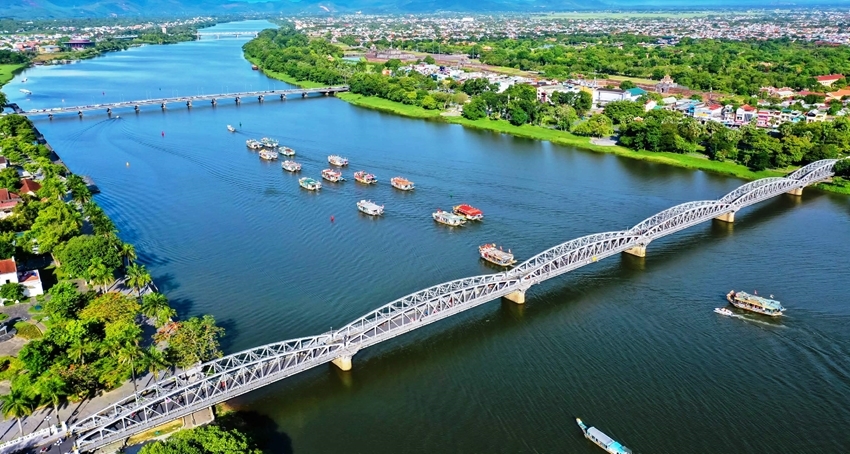 |
| The Perfume River being considered a ‘green pathway’ connecting historical and cultural works |
More than three years after the Province approved the detailed planning project on both sides of the Perfume River, there have been significant changes in the perservation as well as development practices of the poetic river flowing through Hue urban area, which is considered the ‘heritage river’ – the soul of Hue.
Imprints of preservation and development practices
Not only tourists outside the province are overwhelmed by the beauty, poetry, and luxury of the Perfume River, but the people living in Hue are also surprised by the recent changes of the poetic river banks, which look as if they were ‘embracing Hue’.
There are scenes of people cycling, jogging, and playing along the parks along both banks of the river; dragon boats floating gently on the water, along with people rowing and swimming. Altogether, these contribute to creating a ‘symphony’ of the Perfume River. Not every city is as lucky as Hue to own such a unique feature.
“From the upstream to the downstream, every section of the Perfume River has its own beauty. In particular, in recent years, the section of the Perfume River flowing through the heart of Hue city center has become even more poetic because of the buildings and rows of green trees along the wharfs and the river banks. All of these have created extremely beautiful highlights, creating a very unique Hue," said Mr. Nguyen Hoai Phu, a tourist in Ho Chi Minh City.
Mr. Phu has come to Hue many times because he "fell in love" with Hue heritages, with the Perfume River. “In recent years, I recognize that there have been many changes to the Perfume River to make it ‘softer and cuter’. That’s very noticeable and significant in both preservation and development practices,” commented Mr. Phu.
Three years has gone since the detailed planning project on both banks of the Perfume River was approved, and there have been many changes to the Perfume River according to the emphasized orientation, which happens at an impressive speed. These include the harmonious perservation and development practices of space and landscape architecture both along the banks and on the water, extending from the upstream to the downstream.
In addition to the ironwood walkway along the southern bank of the Perfume River, which is considered an impressive project that emphasizes and beautifies the Perfume River, remarkable changes also include the embellishment of Vong Canh hill and Da Vien dunes, the construction of the walkway along the northern bank of the Perfume River which has been extended to Thien Mu Pagoda, the half-moon bridge which has become a public space for ‘‘water sports’. Also, the beautification of the banks of the Perfume River is still continuing with the construction of the walkway along the southern bank from Da Vien dunes which has been extended to the upstream. Moreover, the development of the downstream of the Perfume River, from Bao Vinh to Thuan An seaport with the orientation of prioritizing “natural” elements, which preserves the natural landscape and poetic beauty of the Perfume River and Ngu Binh Mountain, is also worth mentioning.
The river of the history and the future
Dr. Ngo Viet Nam Son, the architect, an international expert in architectural design and planning consulting, who closely follows Hue urban planning in general and the Perfume River planning in particular, affirmed that the Perfume River played the role of the most important landscape axis of Hue city from the past to the present, and especially in the future when Hue becomes a centrally-governed city.
According to this expert's opinion, considering that landscape axis, preserving the Perfume River does not have to cover the entire route, but it is necessary to imagine the Perfume River as a ‘symphony’. This means preserving the central area with the north bank containing Hue Citadel, the south bank containing 20th century heritage buildings, as well as monuments and mausoleums along the river. At the same time, the need for the development of new urban areas along the river is also worth mentioning. “The river represents the history of development hundreds of years ago, which continues into the future. Each river section is a stage of development, harmoniously interrelated and unified,” emphasized Dr. Ngo Viet Nam Son.
In addition to the works that adorn and embellish the banks of the Perfume River in recent years, what Mr. Son is also fond of is the value of green space. Making the banks of the Perfume River green has created the soul of the banks so that people and tourists can enjoy those values, which is something not every city can do.
“The Perfume River is also a ‘green pathway’, connecting historical cultural works as well as modern works in the future. It looks like the ‘living room’ of the urban area and of all people”, added Mr. Son. He also recommended that the construction of works along both banks of the river must be harmonious with the orientation, as well as scientifically and carefully planned, in order to create a unified, attractive landscape.
“I think Hue is heading towards the right direction. The preservation of Hue in general, and the Perfume River in particular, has brought about significant day-by-day changes, making the city more and more prosperous. Hopefully, this trend will continue for other sections of the Perfume River,” shared Mr. Son.
